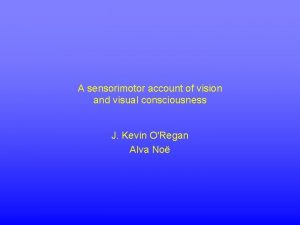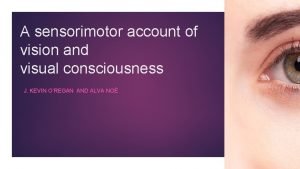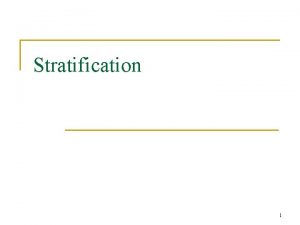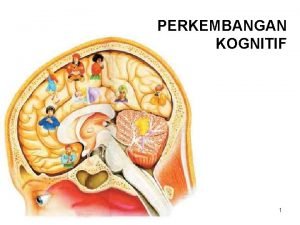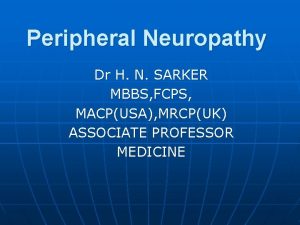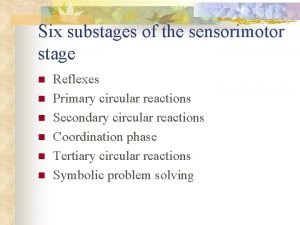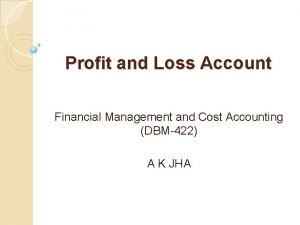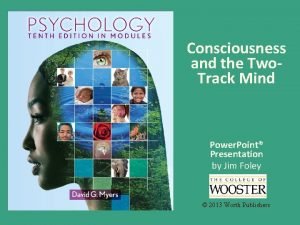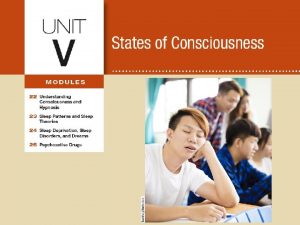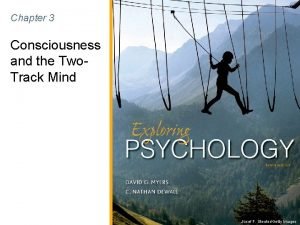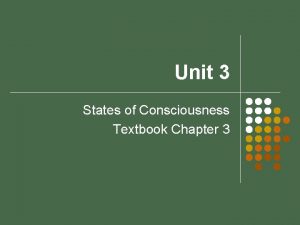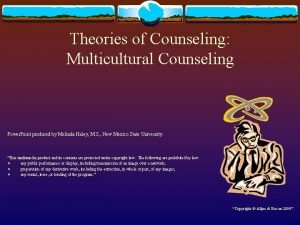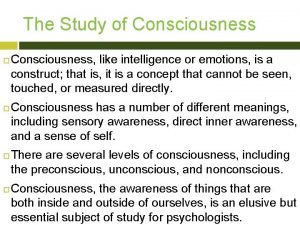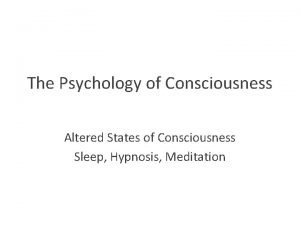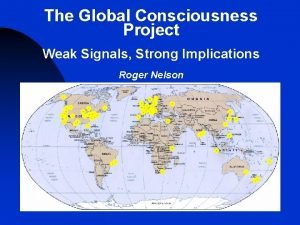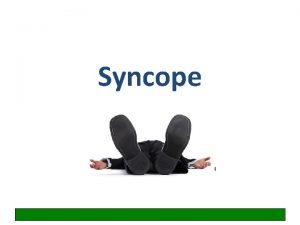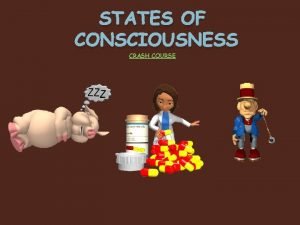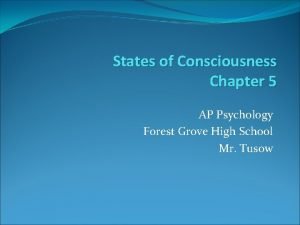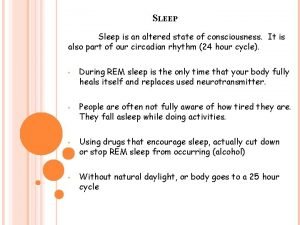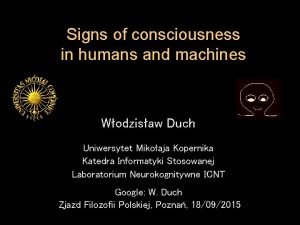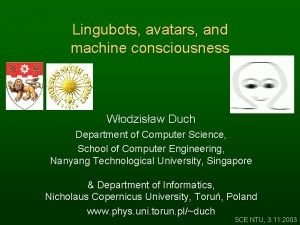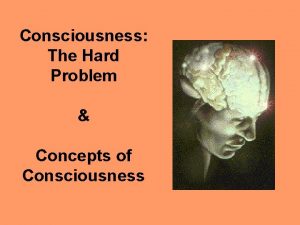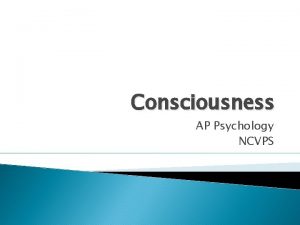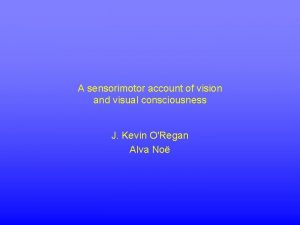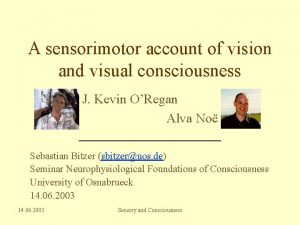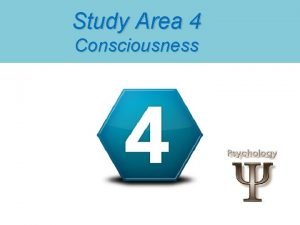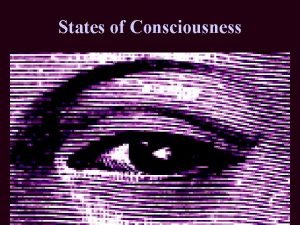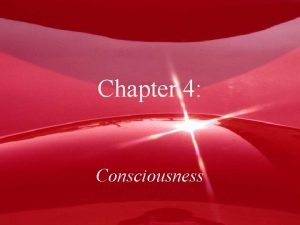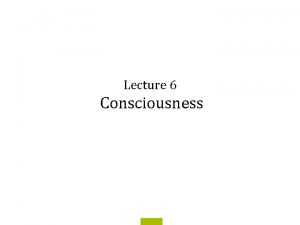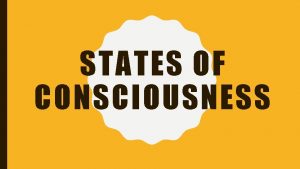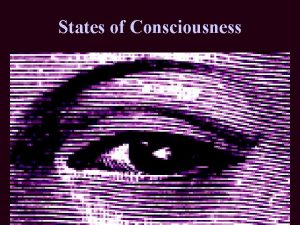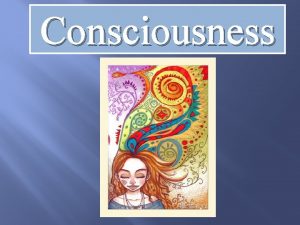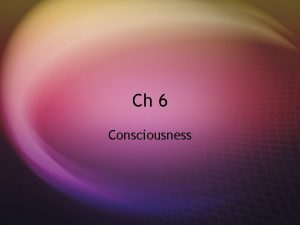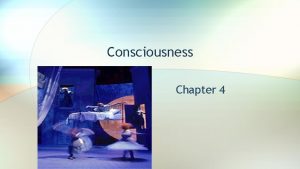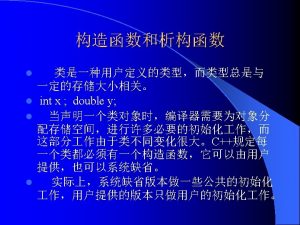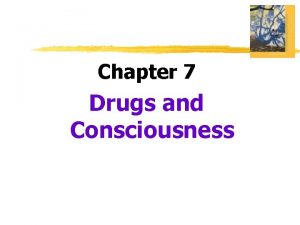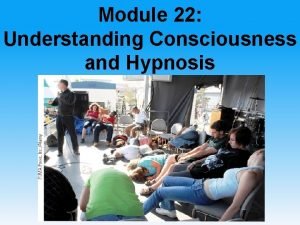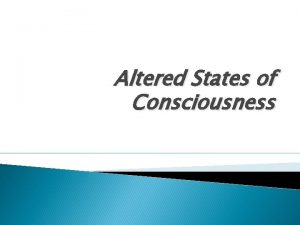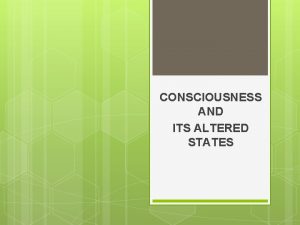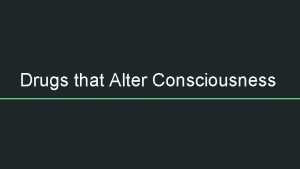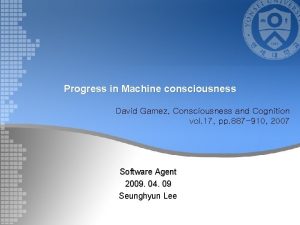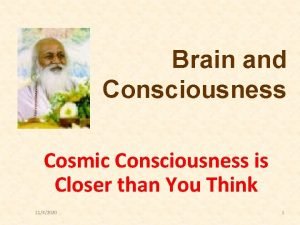A sensorimotor account of vision and visual consciousness


































![5. 11 Inattentional amnesia • Wolfe et al. [1999] use a standard visual search 5. 11 Inattentional amnesia • Wolfe et al. [1999] use a standard visual search](https://slidetodoc.com/presentation_image_h2/7b0fe5b13ae57d91cbe61ecca236bc81/image-35.jpg)






- Slides: 41

A sensorimotor account of vision and visual consciousness J. Kevin O'Regan Alva Noë

1 INTRODUCTION • We propose that seeing is a way of acting. • Activity in internal representations does not generate the experience of seeing. • The experience of seeing occurs when the organism masters what we call the governing laws of sensorimotor contingency.

1. 1 The puzzle of visual experience • What is visual experience and where does it occur? • The hard problem • What would we accept as an explanation?

1. 2 What are sensory modalities? • why is seeing red very different from hearing a sound or smelling a smell? • Why, for example, should more intense neural activity provoke more intense experiences? • Most scientists seem satisfied with some variant of Müller's [1838] classic concept of "specific nerve energy". • Surely the choice of a particular subset of neurons or particular cortical regions cannot, in itself, explain why we attribute visual rather than auditory qualities to this influx. • The hard work is left undone.

1. 3 An alternative approach: the sensorimotor contingency theory • . . . Instead of assuming that vision consists in the creation of an internal representation of the outside world whose activation somehow generates visual experience, we propose to treat vision as an exploratory activity. We then examine what this activity actually consists in. The central idea of the new approach will be that vision is a mode of exploration of the world that is mediated by knowledge of what we call sensorimotor contingencies. .

2 THE STRUCTURE OF VISION As stated above, we propose that vision is a mode of exploration of the world that is mediated by knowledge, on the part of the perceiver, of what we call sensorimotor contingencies. We now explore this claim in detail.

2. 1 Sensorimotor contingencies induced by the visual apparatus • The case of a villainous aquatic monster • It is the same situation as faced by the brain. • It is the structure of the rules • The sensorimotor contingencies within different sensory domains (vision, audition, smell, etc. ) are subject to different (in)variance properties.

2. 2 Sensorimotor contingencies determined by visual attributes • • • On the other hand, tactile exploration of an object, even though it may be sampling the same objective properties, obeys different sensorimotor contingencies: A good illustration of sensorimotor contingencies associated with one particular kind of visual attribute, namely visual shape, can be obtained from the records of patients whose vision has been restored after having been born blind with congenital cataract (c. f. reviews by Morgan [1977], Jeannerod [1975] and Gregory [1973]). One such patient, cited by Helmholtz [1925/1909], is surprised that a coin, which is round, should so drastically change its shape when it is rotated (becoming elliptical in projection). The fact that objects also drastically change in extent as a function of distance is poignantly illustrated by the case of a 13 -14 year old boy treated by Cheseldon (1728, cited by Morgan [1977], p. 20): "Being shewn his father's picture in a locket at his mother's watch, and told what it was, he acknowledged a likeness, but was vastly surpriz'd; asking, how it could be, that a large face could be express'd in so little room, saying, it should have seem'd as impossible to him, as to put a bushel of any thing into a pint. " „The idea we wish to suggest here is that the visual quality of shape is precisely the set of all potential distortions that the shape undergoes when it is moved relative to us, or when we move relative to it. “

2. 3 Sensation and perception • Psychologists interested in perception have traditionally distinguished between sensation and perception. • This corresponds roughly the two different classes of sensorimotor contingencies (visualal-apparatusrelated sensorimotor contingencies and the visualobject-related sensorimotor contingencies).

2. 4 Perceivers must have mastery of patterns of sensorimotor contingency • We suggest that vision requires the satisfaction of two basic conditions. First, the animal must be exploring the environment in a manner that is governed by the two main kinds of sensorimotor contingencies (those fixed by the visual apparatus, and those fixed by the character of objects). Second, the animal, or the brain, must be "tuned to" these laws of sensorimotor contingencies. That is, the animal must be actively exercising its mastery of these laws.

2. 5 Important upshot: • A sensory modality is a mode of exploration mediated by distinctive sensorimotor contingencies • This is just summarizing the line of argumentation above: Visual perception can now be understood as the activity of exploring the environment in ways mediated by knowledge of the relevant sensorimotor contingencies.

2. 6 Visual awareness: • Here attention comes into the game: Integrating sensorimotor contingencies with reasoning and action -guidance • You need to attend to sensory signals in order to exert your mastery of sensorimotor contingencies, and thus to be aware of the sensory signals.

2. 7 Visual consciousness and experience: forms of awareness • that it is somehow mysterious how we can possibly explain this subjective character of experience, or, as it is sometimes put, the "raw feel" or the "qualia" of vision, in neural or other physical terms. Is there any reason to believe the sensorimotor contingency approach can succeed here where others have failed? . . . Stay tuned.

3 REFINEMENTS OF THE VIEW Vision, we argue, requires knowledge of sensorimotor contingencies. To avoid misunderstanding, it is necessary to discuss this claim in greater detail.

3. 1 Knowledge of sensorimotor contingencies is a practical, not a propositional form of knowledge • obvious

3. 2 Mastery must be currently exercised • Another important condition that we need to impose in order that sensorimotor contingencies properly characterize vision, is that the mastery of laws of sensorimotor contingency be exercised now. • Is this different from the activation of representations described before? • only some are applicable at the present moment.

3. 3 Historical note: relation to other similar ideas • This is beyond the scope of the presentation. Suffice it to say, a lot of previous work is closely related to the present article, nothing quite exactly like it.

4 THE WORLD AS AN OUTSIDE MEMORY An important related idea

4. 1 The world as an outside memory • Under the present theory, visual experience does not arise because an internal representation of the world is activated in some brain area. On the contrary, visual experience is a mode of activity involving practical knowledge about currently possible behaviors and associated sensory consequences. Visual experience rests on know-how, the possession of skills. • Or, if you do not have a decent internal representation, you need the world

4. 2 The impression of seeing everything • How then, if at any moment only a small fragment of the world is actually being seen, could we ever have that strong subjective impression that we continually have of seeing "everything"? • Because you potentially can direct your attention to it.

4. 3 Vividness through transients • It is important, but I do not fully understand this part.

4. 4 Dreaming and mental imagery • This does not seem to be that important, nor that clear.

4. 5 Seeing without eye movements • • achistoscopic stimulus presentation techniques are widely used. As an illustration, consider an experiment in which observers were asked to learn to distinguish three previously unknown symbols resembling Chinese characters (Nazir & O'Regan [1990]). These were presented under the control of a computer linked to an eye movement measuring device. In one experiment, conditions were arranged so that observers could contemplate each Chinese symbol with their eyes fixated at the middle of the symbol, but as soon as the eyes moved, the symbol would disappear. Observers found this procedure extremely disrupting and irritating, and, contrary to what happens when the eye is free to move, hundreds of trials were necessary before they were able to distinguish the symbols. Furthermore, once the task was learnt, observers often failed when asked to recognize the learnt patterns at a new retinal location, only as little as half a degree away from the learnt position.

4. 6 Why we don't see behind ourselves, but we do see partially occluded objects • Figure 2. Subjects tend to remember having seen a greater expanse of a scene than was shown in a photograph. For example, when drawing the close-up view in Panel A from memory, the subject's drawing (Panel C) contained extended boundaries. Another subject, shown a more wide-angle view of the same scene (Panel B), also drew the scene with extended boundaries (Panel D).

5 EMPIRICAL DATA. the empirical data to be presented is not intended as a test of theory in the everyday sense that theories are tested in science

5. 2 The extraretinal signal • A large portion of the experimental literature on the subject has assumed the existence of an internal representation, like a panoramic internal screen, into which successive snapshots of the visual world are inserted so as to create a fused global patchwork of the whole visual environment. . • This would be pretty difficult, and misguided. • The data concur to show that if the extraretinal signal exists, it is very inaccurate.

5. 3 Trans-saccadic fusion • This is where O‘Regan comes from. • . . . The conclusion is consistent with theory presented here, where the problem of visual stability is a non-problem. • The world as an external memory

5. 4 Saccadic suppression • Similar argumentation, it is a non-problem

5. 5 Filling in the blind spot and perceptual completion • Not a problem as well, just a more extreme case of a retinal non-homogeneity, i. e. a sensorimotor contingency.

5. 6 Other retinal non-homogeneities and the perception of color • The world is not described as gray level at higher eccentricities

5. 7 "Red" is knowing the structure of the changes that "red" causes • when a surface is moved so that it reflects more yellowish sunlight and less bluish light from the sky, the particular way the spectrum of the reflected light changes, disambiguates the surface's color, and allows that color to be ascertained correctly even when the observer is a dichromat.

5. 8 Eye-position contingent perception • A surprising prediction from this idea, that the sensation of red comes from the structure of changes that is caused by red, is the following armchair experiment. Using a device to measure eye movements connected to a computer, it should be possible to arrange stimulation on a display screen so that whenever an observer looks directly at a patch of color it appears red, but whenever the observer's eye looks away from the patch, its color changes to green. The rather counterintuitive prediction from this is that after training in this situation, the observer should come to have the impression that green patches in peripheral vision and red patches in central vision are the same color.

5. 9 Inversion of the visual world • Relevant to theory of visual experience being proposed here, are the classic experiments performed by Stratton [1897], Kohler [1951], and some less often cited replications by Taylor [1962] and by Dolezal [1982] and Kottenhoff [1961], in which an observer wears an optical apparatus which inverts the retinal image so that the world appears upsidedown and/or left-right inverted (c. f. reviews by e. g. Harris [1965]; [1980]). • All thisis explained naturally by the present theory.

5. 10 Change blindness experiments
![5 11 Inattentional amnesia Wolfe et al 1999 use a standard visual search 5. 11 Inattentional amnesia • Wolfe et al. [1999] use a standard visual search](https://slidetodoc.com/presentation_image_h2/7b0fe5b13ae57d91cbe61ecca236bc81/image-35.jpg)
5. 11 Inattentional amnesia • Wolfe et al. [1999] use a standard visual search paradigm in which a subject must search for a target symbol among a number of distractor symbols. The authors estimate the efficiency of the search in milliseconds per item searched. However, instead of using a new display of distractors on each trial as is usually done, the authors use exactly the same visual display over a number of repetitions, but each time change the target that the subject is looking for. Since subjects are looking at the same display, which remains continuously visible on the screen for anything from 5 to 350 repetitions, depending on the experiment, one might have expected that an internal representation of the display would have time to build up, allowing search rate to improve over repetitions. However this is not what is found: Over a number of experiments using different kinds of stimuli, Wolfe et al. [1999] find no evidence of improvement in search rate. It seems that no internal representation of the display is being built up over repetitions. In fact, search rate is as bad after many repeated searches as in the normal visual search conditions when the display changes at every trial: in other words, it is as though the subjects think they are searching through a brand new display at each trial, even though it is exactly the same display as before.

5. 12 Informal examples • These are examples you know well from other work, and which are used as illustrations in a wide variety of theories

5. 13 Remote tactile sensing • Particularly interesting is the work being done by Lenay [1997], using an extreme simplification of the echolocation device, in which a blind or blindfolded person has a single photoelectric sensor attached to his or her forefinger, and can scan a simple environment (e. g. consisting of several isolated light sources) by pointing. .

5. 14 Tactile visual sensory substitution • In an anecdote reported by Bach y Rita, the zoom control of the camera being used by a well -trained subject was moved, causing a sudden magnification or "looming" of the tactile image. Bach y Rita states ([1972] p. 98): ". . the startled subject raised his arms and threw his head backward to avoid the `approaching' object. It is noteworthy that, although the stimulus array was, at the time, on the subject's back, he moved backward and raised his arms in front to avoid the object, which was subjectively located in the three-dimensional space before him. "[37]Another interesting observation caused puzzlement in the early investigations with the TVSS. For practical reasons the battery of 400 vibrators mounted on the observer's back consisted in two ramps of 200 vibrators, one on each side of the observer's backbone. A large gap was therefore present in the tactile representation of the visual field. "Curiously" however, no gap was apparent in observers' perceived visual field. This tactile analog of what might incorrectly be called "filling-in" of the retinal blind spot is of course unsurprising in the light of the present theory, where no filling-in mechanism need be postulated

5. 15 The "facial vision" of the blind

Summary of 5 • • • • The extraretinal signal Trans-saccadic fusion Saccadic suppression Filling in the blind spot and perceptual completion Other retinal non-homogeneities and the perception of color "Red" is knowing the structure of the changes that "red" causes Eye-position contingent perception Inversion of the visual world Change blindness experiments Inattentional amnesia Informal examples Remote tactile sensing Tactile visual sensory substitution The "facial vision" of the blind

. . . 9 CONCLUSION • In this paper we have put forward a new framework for thinking about the nature of vision and visual consciousness. The solution to the puzzle of understanding how consciousness arises in the brain is to realize that consciousness does not in fact arise in the brain! Visual consciousness is not a special kind of brain state, or a special quality of informational states of the brain. It is something we do.
 A sensorimotor account of vision and visual consciousness
A sensorimotor account of vision and visual consciousness A sensorimotor account of vision and visual consciousness
A sensorimotor account of vision and visual consciousness Type of social mobility
Type of social mobility Real and nominal account example
Real and nominal account example Tahap perkembangan moral menurut piaget
Tahap perkembangan moral menurut piaget Hubungkan 16 titik dengan 6 garis tanpa putus
Hubungkan 16 titik dengan 6 garis tanpa putus Sensorimotor polyneuropathy
Sensorimotor polyneuropathy Jean piaget bio
Jean piaget bio Partially concealed
Partially concealed Errors revealed by trial balance with examples
Errors revealed by trial balance with examples Particulars
Particulars First hand account and secondhand account
First hand account and secondhand account Account receivable account title
Account receivable account title Short working
Short working Structured light
Structured light Dual track mind
Dual track mind Social influence theory of hypnosis
Social influence theory of hypnosis Two track mind examples
Two track mind examples Yang termasuk bahasa pemrograman konvensional adalah
Yang termasuk bahasa pemrograman konvensional adalah What is the stream of consciousness technique
What is the stream of consciousness technique 3 states of consciousness
3 states of consciousness Time of useful consciousness
Time of useful consciousness Multicultural counseling theories
Multicultural counseling theories Levels of consciousness examples
Levels of consciousness examples Altered state of consciousness psychology
Altered state of consciousness psychology Global conciousness project
Global conciousness project Molly ivors
Molly ivors Loss of consciousness
Loss of consciousness Reciprocal determinism definition psychology
Reciprocal determinism definition psychology Crash course states of consciousness
Crash course states of consciousness States of consciousness ap psychology
States of consciousness ap psychology Growth sleep
Growth sleep Signs of consciousness
Signs of consciousness Why did jack want samneric to get him a coconut
Why did jack want samneric to get him a coconut The hard problem of consciousness
The hard problem of consciousness Perbedaan consciousness dan awareness
Perbedaan consciousness dan awareness Stream of consciousness technique
Stream of consciousness technique Global consciousness project 9/11
Global consciousness project 9/11 Hard problem of consciousness
Hard problem of consciousness Consciousness definition ap psychology
Consciousness definition ap psychology 7 states of consciousness
7 states of consciousness Noxious stimuli
Noxious stimuli
